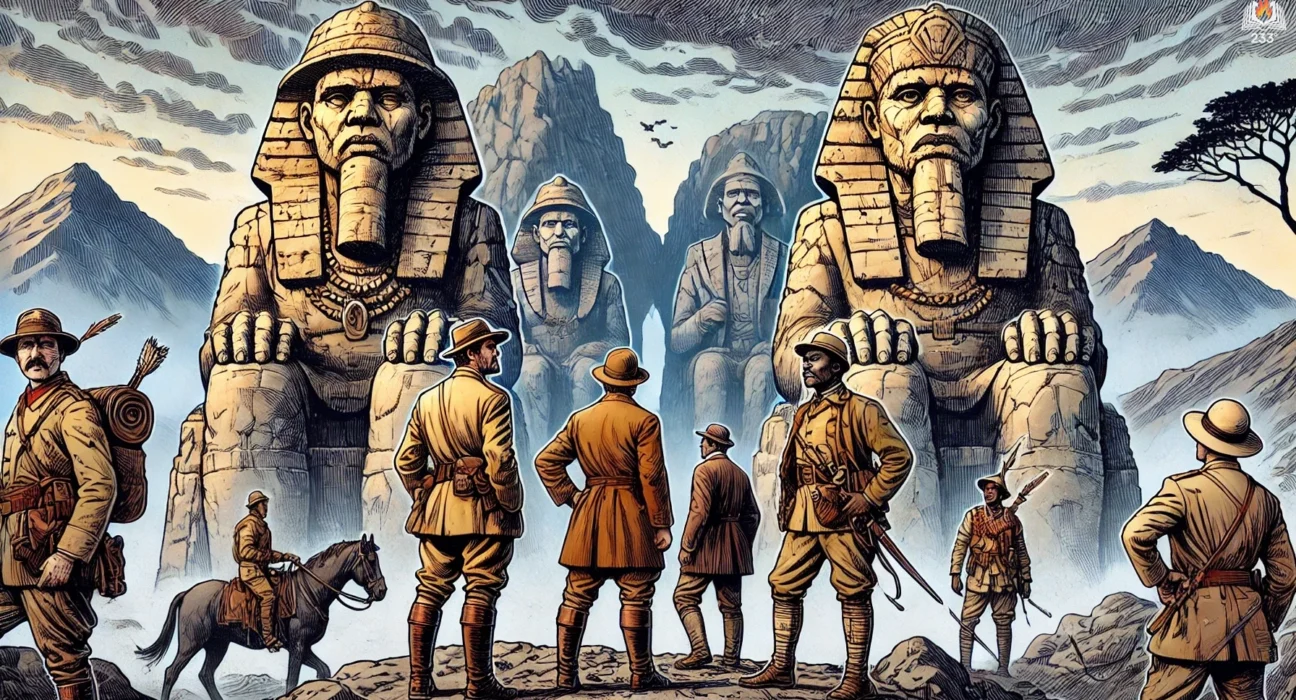King Solomon’s Mines is a classic adventure novel written by H. Rider Haggard and first published in 1885. It is widely regarded as one of the earliest examples of the “lost world” genre, blending action, exploration, and intrigue. The story is narrated by Allan Quatermain, an experienced British hunter and adventurer, who leads an expedition into the uncharted African wilderness in search of the legendary diamond mines of King Solomon. Quatermain, along with Sir Henry Curtis and Captain John Good, embarks on a perilous journey through dangerous terrain, facing native tribes, ancient secrets, and deadly challenges. The novel is a thrilling tale of treasure hunting and survival, with a backdrop of African mysticism and colonial-era exploration.
Plot Summary
In the heart of South Africa, Allan Quatermain, an experienced hunter and explorer, finds himself reluctantly agreeing to a dangerous expedition. Approached by Sir Henry Curtis and his companion, Captain John Good, Quatermain is asked to help them find Sir Henry’s missing brother, George Neville, who vanished while searching for the fabled mines of King Solomon. Despite Quatermain’s reservations, the promise of riches for his son’s future, along with Sir Henry’s persistence, convinces him to join the journey. A mysterious Zulu man named Umbopa also volunteers for the expedition, harboring secrets of his own.
Their journey begins in the barren desert, a scorching, hostile landscape where survival becomes an immediate challenge. As they travel northward, they encounter hardships that test their endurance: scorching heat, dehydration, and the endless threat of death. The desert seems to stretch on forever, and even Quatermain, accustomed to such harsh terrains, begins to fear the worst. It is only through their combined resilience and hope of finding the legendary mines that they push forward.
After narrowly surviving the desert, the expedition reaches the lush and fertile lands of Kukuanaland, a hidden kingdom isolated from the rest of the world. Here, they are captured by the Kukuanas, a warlike and formidable tribe ruled by the tyrant King Twala. Twala’s reign is one of terror and oppression, his throne secured through treachery and bloodshed. He killed his own brother to ascend the throne and now rules with an iron fist, assisted by the ancient and sinister witch, Gagool. Twala’s people live in fear of his cruelty, and any sign of rebellion is swiftly quashed by his merciless army.
It is revealed that Umbopa is not merely a servant but the rightful heir to the throne of Kukuanaland. His true identity is Ignosi, the son of Twala’s murdered brother, and he has returned to reclaim his birthright. With the support of Quatermain, Sir Henry, and Good, Ignosi challenges Twala’s rule. A civil war ensues, with Ignosi leading a rebellion against the tyrant king. The battle is fierce and bloody, but Ignosi’s forces, bolstered by the experience and tactical knowledge of his new allies, manage to overthrow Twala.
Twala is killed in the battle, and Ignosi is proclaimed king. His first act as ruler is to restore peace and justice to his people, promising to end the bloodshed and fear that Twala’s rule had imposed. Grateful to his friends, Ignosi grants them safe passage through his kingdom and offers to help them find the fabled mines they came for.
Guided by the cunning and ancient Gagool, who knows the location of King Solomon’s Mines, the adventurers are led to the fabled treasure trove deep within the mountains. The entrance to the mines lies within a vast cavern, guarded by enormous statues known as the “Silent Ones.” These figures, carved from stone and shrouded in mystery, watch over the entrance like sentinels from a long-forgotten age. Inside, they discover an immense chamber filled with diamonds, gold, and other unimaginable riches—treasures that had once belonged to the legendary King Solomon himself.
But as with all great rewards, danger is never far behind. Gagool, ever treacherous and cunning, reveals her true intent. She had only guided them to the mines to trap them inside. As the adventurers attempt to leave with their newfound wealth, Gagool triggers a trap, causing the entrance to collapse. She cackles in glee at their fate but is crushed by falling rocks, her own malevolence sealing her doom. The explorers are left trapped in the darkness, surrounded by untold riches but with no apparent way out.
For days, they struggle to find an escape. As their supplies dwindle and hope begins to fade, they discover a hidden passage, long forgotten by even the ancients who had once mined the riches. Exhausted but determined, they follow the narrow tunnel, which leads them back to the surface and the freedom of the open air. Their ordeal beneath the mountain has cost them dearly, but they emerge alive, though with only a few diamonds as proof of their discovery.
Returning to Kukuanaland, they find that Ignosi has kept his word, ruling with wisdom and fairness. Grateful for their assistance in securing his throne, he ensures that Quatermain, Sir Henry, and Good are richly rewarded, though the treasure they had hoped for is far less than they had imagined. For Sir Henry, the greatest reward is discovering that his brother, though having reached the mines, perished during his journey. A skeleton, found within the mines, is identified as George Neville, bringing closure to Sir Henry’s long search.
With their task complete and the dangers behind them, the adventurers prepare to return to civilization. They have not found the unimaginable wealth they sought, but they leave with something far more valuable: the bonds of friendship forged through hardship, the memories of an extraordinary journey, and the satisfaction of having helped restore a just king to his rightful throne. Quatermain, ever the practical man, is content to return to his quiet life, knowing that the adventure has left an indelible mark on his soul.
As they part ways with Ignosi and the Kukuanas, they take one last look at the majestic mountains that hide the fabled mines of King Solomon, knowing that the world will never truly understand the dangers and wonders that lie within.
Main Characters
Allan Quatermain: The narrator and protagonist, Quatermain is a seasoned hunter and explorer, pragmatic and cautious by nature. At 55 years old, he is weary of adventure but agrees to undertake this journey for the financial security of his son. His experience in Africa and deep knowledge of its cultures and dangers make him a natural leader of the expedition.
Sir Henry Curtis: A physically imposing man with Danish ancestry, Sir Henry is the driving force behind the expedition. He is motivated by the desire to find his lost brother, who vanished while searching for the fabled mines. Noble and determined, Sir Henry demonstrates unwavering courage throughout the journey.
Captain John Good: A British naval officer who joins the expedition, Good is meticulous, practical, and somewhat humorous, often providing comic relief. His bravery, quick thinking, and medical knowledge make him an invaluable companion on the dangerous trek.
Umbopa: A mysterious and noble Zulu man who joins the expedition as a servant, Umbopa’s true identity and motivations gradually unfold. His stoicism, physical prowess, and intelligence play a crucial role in the success of the adventure.
Twala: The tyrannical king of the Kukuanas, Twala is a brutal ruler who governs through fear and violence. His reign is marked by cruel practices, and he becomes a significant antagonist to the explorers.
Gagool: An ancient, malevolent witch-doctor serving Twala, Gagool is portrayed as manipulative and terrifying. Her knowledge of the hidden mines and their treasures makes her a pivotal character in the story’s climax.
Theme
Colonial Exploration and Adventure: The novel taps into the 19th-century fascination with Africa as a land of mystery and opportunity. The journey into uncharted territories reflects the colonial mindset of discovery, adventure, and exploitation of the unknown for personal and national gain.
Greed and the Allure of Wealth: The search for King Solomon’s legendary diamond mines is driven by the characters’ varying desires for wealth and power. The novel explores how the promise of immense riches can lead to danger and destruction, highlighting both the seductive and perilous nature of greed.
Courage and Friendship: The camaraderie between Quatermain, Curtis, and Good underscores the theme of loyalty and trust in the face of overwhelming odds. Their bond strengthens as they navigate deadly challenges, demonstrating the importance of friendship in survival.
Cultural Clash and Superiority: The novel reflects the colonial attitudes of the time, portraying African societies as exotic and primitive compared to European civilization. However, the character of Umbopa complicates this narrative by challenging notions of racial and cultural superiority.
The Supernatural and the Unknown: Throughout the novel, there are recurring elements of mystery and the supernatural, particularly through Gagool and the ancient legends of the Kukuanas. These motifs add an aura of mysticism to the story, blurring the line between reality and legend.
Writing Style and Tone
H. Rider Haggard’s writing in King Solomon’s Mines is straightforward, adventurous, and richly descriptive, emphasizing the harsh beauty of the African landscape. Quatermain’s narrative voice is informal and conversational, often infused with dry humor and self-deprecation, which makes the reader feel like they are hearing a personal account of the events. Haggard excels in crafting vivid depictions of both action sequences and the natural environment, bringing the wilds of Africa to life.
The tone of the novel shifts between excitement and tension, often balancing moments of danger with lighter, more humorous interludes, especially through the interactions between the main characters. While the novel is undoubtedly a product of its time, reflecting Victorian ideals of heroism and adventure, it also delves into darker themes, particularly through the violent and treacherous world the characters encounter. The underlying colonial mentality, though present, is tempered by the acknowledgment of African wisdom and strength, especially through characters like Umbopa.
We hope this summary has sparked your interest and would appreciate you following Celsius 233 on social media:
There’s a treasure trove of other fascinating book summaries waiting for you. Check out our collection of stories that inspire, thrill, and provoke thought, just like this one by checking out the Book Shelf or the Library
Remember, while our summaries capture the essence, they can never replace the full experience of reading the book. If this summary intrigued you, consider diving into the complete story – buy the book and immerse yourself in the author’s original work.
If you want to request a book summary, click here.
When Saurabh is not working/watching football/reading books/traveling, you can reach him via Twitter/X, LinkedIn, or Threads
Restart reading!








